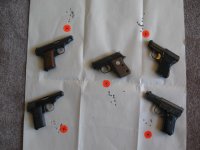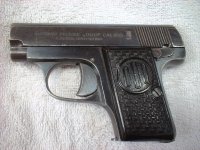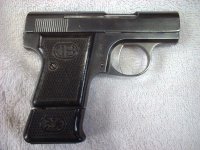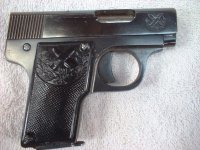Recent threads regarding .25 ACP pistols interested me. Several years ago, before I turned my attention to S&W and Colt revolvers, I was collecting pre-war pocket pistols mostly in .32 caliber. Along the way, I also picked up quite a few .25 & .380 models.
One of the questions raised in the thread was "how accurate are the little .25 caliber pistols". I haven't shot them in quite a few years but seem to recall that they could shoot better than most people give them credit. So since I was planning to go to the range anyway, I grabbed 5 representative examples from my collection, a box of CCI aluminum cased Blazer ammo and was off to see what they could do.
Shooting these little guns is a bit of a challenge for me as I have big hands. Getting a good grip and avoiding slide bit is a problem with some of them. Despite that I think they did pretty well. Targets were shot at 7 yards using an unsupported, two-hand hold. When doing accuracy tests, I like to use a small target dot and aim at the 6:00 position. This gives a consistent & focused aim point and the light colored target board makes seeing the tiny sights easier.
I don't like to make excuses for my shooting but I think the groups could have been better. After setting up my station, a new guy arrived and set up at the station right next to me. Literally about arms length away. While I was doing my little test, he was blazing away, rapid fire with a short barreled semi-auto in .40 S&W. A few rounds went down range not quite at the moment of my choosing.
Each gun was fired with two consecutive magazines loaded with 5 rounds each [10 rounds total per gun]
Going around the target based on barrel length:
Center Target: Colt Jr.
Newest gun of the group probably around 1970's era. Astra made version of the baby Browning for Colt. Barrel length was approximately 2.25 inches and is overall the smallest of the guns in length and height but the thickest. Gun has a very short grip but because it is so thick a good positive grip is possible. Had no issues with slide bite and gun was completely reliable. Was the only gun to group low and right for me. The one wild round way right was the first shot fired. Shooter error or cold barrel flyer... not sure.
Upper Right Target: Beretta 418
Probably around mid-150's era. The original "James Bond" gun. Barrel length approximately 2. 38 inches. The Beretta is the lightest of all the guns with it's aluminum frame. Comfortable to hold but the most unpleasant to shoot. Not that the .25 ACP is brutal but the light gun also has rather sharp edges on the grip frame and recoil is more noticeable in this gun that all the others tested. It was also completely reliable for the 10 rounds tested.
Upper Left Target: Ortgies
This is a very tiny gun. Circa 1920's. Barrel length approximately 2.65 inch. While grouping was good, it was a challenge to shoot. The trigger guard is too small for my fingers. Trigger finger rubs between the frame and trigger guard, and the slide hits the web of my hand on every shot. Also had several failures to fully chamber a round as a result. Pretty sure the interference between my hand and the slide was mostly responsible. Gun was otherwise reliable.
Lower Left Target: Walther Model 8
Also a very tiny gun. Circa 1930's This gun also had the heaviest trigger pull. Barrel length approximately 2.94 inch. Trigger guard is just enough bigger than the Ortgies to not be an issue. But this gun also suffered failures to fully chamber a round several times. Again, I think this is due to the slide trying to take a bite out of the web of my hand on every shot. Like the Ortgies, once the round(s) chambered, the gun was otherwise reliable in ignition and ejection. Also worth noting that this gun for me shot closest to point of aim.
Lower Right Target: Mauser Model 1910
The largest of my .25 ACP pistols in all dimensions except thickness. Barrel length approximately 3.15 inch. Circa 1914. The most pleasant of the guns to shoot and think it has the best accuracy potential despite my example having a very worn and pitted barrel. No issues with slide bite and a very good trigger. Unfortunately, it was only possible to fire 5 of the 10 test rounds. Sent the cartridges thru the gun as many as four times without ignition. Primers showed only the faintest of firing pin strikes. When I got home and disassembled the gun found what I believe to be the problem. The firing pin itself is very low mass and when in its forward position, the firing pin spring isn't even in contact with it any longer. Gun must have been stored with the spring compressed for years. Pretty positive a new firing pin spring will fully resolve the issue.
I hope you found this interesting. Not that I recommend the .25 ACP as either a serious self-defense pistol with all the better options available today nor as a target pistol. But they are interesting and fun collectables from another era and capable of pretty decent close-range accuracy if you've inclined to shoot them.
I may try repeating this little test in the future with some new springs, fresh gun oil, some different ammo and a quieter shooting position! Might even set up the Chronograph and see if the barrel length makes any meaningful difference in velocity.
One of the questions raised in the thread was "how accurate are the little .25 caliber pistols". I haven't shot them in quite a few years but seem to recall that they could shoot better than most people give them credit. So since I was planning to go to the range anyway, I grabbed 5 representative examples from my collection, a box of CCI aluminum cased Blazer ammo and was off to see what they could do.
Shooting these little guns is a bit of a challenge for me as I have big hands. Getting a good grip and avoiding slide bit is a problem with some of them. Despite that I think they did pretty well. Targets were shot at 7 yards using an unsupported, two-hand hold. When doing accuracy tests, I like to use a small target dot and aim at the 6:00 position. This gives a consistent & focused aim point and the light colored target board makes seeing the tiny sights easier.
I don't like to make excuses for my shooting but I think the groups could have been better. After setting up my station, a new guy arrived and set up at the station right next to me. Literally about arms length away. While I was doing my little test, he was blazing away, rapid fire with a short barreled semi-auto in .40 S&W. A few rounds went down range not quite at the moment of my choosing.
Each gun was fired with two consecutive magazines loaded with 5 rounds each [10 rounds total per gun]
Going around the target based on barrel length:
Center Target: Colt Jr.
Newest gun of the group probably around 1970's era. Astra made version of the baby Browning for Colt. Barrel length was approximately 2.25 inches and is overall the smallest of the guns in length and height but the thickest. Gun has a very short grip but because it is so thick a good positive grip is possible. Had no issues with slide bite and gun was completely reliable. Was the only gun to group low and right for me. The one wild round way right was the first shot fired. Shooter error or cold barrel flyer... not sure.
Upper Right Target: Beretta 418
Probably around mid-150's era. The original "James Bond" gun. Barrel length approximately 2. 38 inches. The Beretta is the lightest of all the guns with it's aluminum frame. Comfortable to hold but the most unpleasant to shoot. Not that the .25 ACP is brutal but the light gun also has rather sharp edges on the grip frame and recoil is more noticeable in this gun that all the others tested. It was also completely reliable for the 10 rounds tested.
Upper Left Target: Ortgies
This is a very tiny gun. Circa 1920's. Barrel length approximately 2.65 inch. While grouping was good, it was a challenge to shoot. The trigger guard is too small for my fingers. Trigger finger rubs between the frame and trigger guard, and the slide hits the web of my hand on every shot. Also had several failures to fully chamber a round as a result. Pretty sure the interference between my hand and the slide was mostly responsible. Gun was otherwise reliable.
Lower Left Target: Walther Model 8
Also a very tiny gun. Circa 1930's This gun also had the heaviest trigger pull. Barrel length approximately 2.94 inch. Trigger guard is just enough bigger than the Ortgies to not be an issue. But this gun also suffered failures to fully chamber a round several times. Again, I think this is due to the slide trying to take a bite out of the web of my hand on every shot. Like the Ortgies, once the round(s) chambered, the gun was otherwise reliable in ignition and ejection. Also worth noting that this gun for me shot closest to point of aim.
Lower Right Target: Mauser Model 1910
The largest of my .25 ACP pistols in all dimensions except thickness. Barrel length approximately 3.15 inch. Circa 1914. The most pleasant of the guns to shoot and think it has the best accuracy potential despite my example having a very worn and pitted barrel. No issues with slide bite and a very good trigger. Unfortunately, it was only possible to fire 5 of the 10 test rounds. Sent the cartridges thru the gun as many as four times without ignition. Primers showed only the faintest of firing pin strikes. When I got home and disassembled the gun found what I believe to be the problem. The firing pin itself is very low mass and when in its forward position, the firing pin spring isn't even in contact with it any longer. Gun must have been stored with the spring compressed for years. Pretty positive a new firing pin spring will fully resolve the issue.
I hope you found this interesting. Not that I recommend the .25 ACP as either a serious self-defense pistol with all the better options available today nor as a target pistol. But they are interesting and fun collectables from another era and capable of pretty decent close-range accuracy if you've inclined to shoot them.
I may try repeating this little test in the future with some new springs, fresh gun oil, some different ammo and a quieter shooting position! Might even set up the Chronograph and see if the barrel length makes any meaningful difference in velocity.
Attachments
Last edited:






